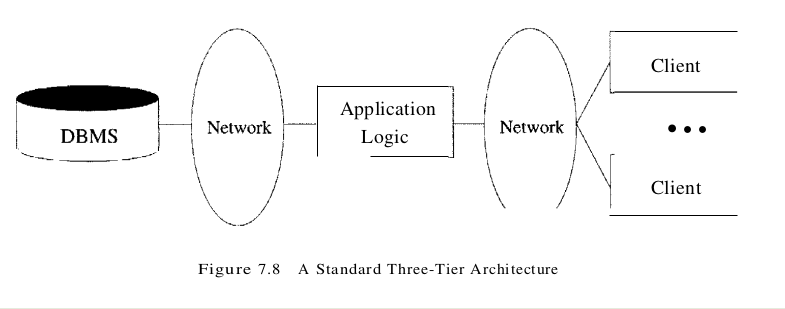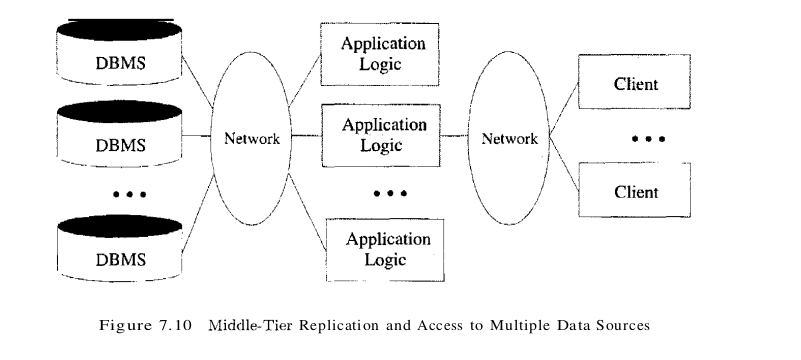A major problem in embedding SQL statements in a host language like C is that an impedance mismatch occurs because SQL operates on set” of records, whereas languages like C do not cleanly support a set-of-records abstraction. The solution is to essentially provide a mechanism that allows us to retrieve rows one at a time from a relation.
This mechanism is called a cursor. We can declare a cursor on any relation or on any SQL query (because every query returns a set of rows). Once a cursor is declared, we can open it (which positions the cursor just before the first row); fetch the next row; move the cursor (to the next row, to the row after the next n, to the first row, or to the previous row, etc., by specifying additional parameters for the FETCH command); or close the cursor. Thus, a cursor essentially allows us to retrieve the rows in a table by positioning the cursor at a particular row and reading its contents.
Internet Applications
The Three-Tier Application Architecture
Data-intensive Internet applications can be understood in terms of three different functional components: data management, application logic, and presentation. The component that handles data management usually utilizes a DBMS for data storage, but application logic and presentation involve much more than just the DBMS itself.
Single-Tier and Client-Server Architecture
In this section, we provide some perspective on the three-tier architecture by discussing single-tier and client-server architectures, the predecessors of the three-tier architecture. Initially, data-intensive applications were combined into a single tier, including the DBMS, application logic, and user interface, as illustrated in Figure 7.5. The application typically ran on a mainframe, and users accessed it through dumb terminals that could perform only data input and display. This approach has the benefit of being easily maintained by a central administrator.

Single-tier architectures have an important drawback: Users expect graphical interfaces that require much more computational power than simple dumb terminals. Centralized computation of the graphical displays of such interfaces requires much more computational power than a single server has available, and thus single-tier architectures do not scale to thousands of users. The commoditization of the PC and the availability of cheap client computers led to the development of the two-tier architecture.
Two-tier architectures, often also referred to as client-server architectures, consist of a client computer and a server computer, which interact through a well-defined protocol. What part of the functionality the client implements, and what part is left to the server, can vary. In the traditional client-server architecture, the client implements just the graphical user interface, and the server. implements both the business logic and the data management; such clients are often called thin clients, and this architecture is illustrated in Figure 7.6. Other divisions are possible, such as more powerful clients that implement both user interface and business logic, or clients that implement user interface and part of the business logic, with the remaining part being implemented at the server level; such clients are often called thick clients
Over the last ten years, a large number of client-server development tools such Microsoft Visual Basic and Sybase Powerbuilder have been developed. These tools permit rapid development of client-server software, contributing to the success of the client-server model, especially the thin-client version. The thick-client model has several disadvantages when compared to the thin-client model. First, there is no central place to update and maintain the business logic, since the application code runs at many client sites. Second, a large amount of trust is required between the server and the clients. As an example, the DBMS of a bank has to trust the (application executing at an) ATM machine to leave the database in a consistent state. (One way to address this problem is through stored procedures, trusted application code that is registered with the DBMS and can be called from SQL statelnents.
A third disadvantage of the thick-client architecture is that it does not scale with the number of clients; it typically cannot handle more than a few hundred clients. The application logic at the client issues SQL queries to the server and the server returns the query result to the client, where further processing takes place. Large query results might be transferred between client and server. Fourth, thick-client systems do not scale as the application accesses more and more database systems. Assume there are x different database systems that are accessed by y clients, then there are x * y different connections open at any time, clearly not a scalable solution.
Three-Tier Architectures
The thin-client two-tier architecture essentially separates presentation issues from the rest of the application. The three-tier architecture goes one step further, and also separates application logic from data management:
- Presentation Tier: Users require a natural interface to make requests, provide input, and to see results. The widespread use of the Internet has made Web-based interfaces increasingly popular.
- Middle Tier: The application logic executes here. An enterprise-class application reflects complex business processes, and is coded in a general purpose language such as C++ or Java.
- Data Management Tier: Data-intensive Web applications involve DBMSs.
Figure 7.8 shows a basic three-tier architecture. Different technologies have been developed to enable distribution of the three tiers of an application across multiple hardware platforms and different physical sites.

At the presentation layer, we need to provide forms through which the user can issue requests, and display responses that the middle tier generates. The hypertext markup language (HTML) is the basic data presentation language.
The middle layer runs code that implements the business logic of the application: It controls what data needs to be input before an action can be executed, determines the control flow between multi-action steps, controls access to the database layer, and often assembles dynamically generated HTML pages from database query results. The middle tier code is responsible for supporting all the different roles involved in the application. For example, in an Internet shopping site implementation, we would like customers to be able to browse the catalog and make purchases, administrators to be able to inspect current inventory, and possibly data analysis to ask summary queries about purchase histories. Each of these roles can require support for several complex actions. For example, consider the a customer who wants to buy an item (after browsing or searching the site to find it). Before a sale can happen, the customer has to go through a series of steps: She has to add items to her shopping basket, she has to provide her shipping address and credit card number (unless she has an account at the site), and she has to finally confirm the sale with tax and shipping costs added. Controlling the flow among these steps and remembering already executed steps is done at the middle tier of the application. The data carried along during this series of steps might involve database accesses, but usually it is not yet permanent (for example, a shopping basket is not stored in the database until the sale is confirmed).
Advantage of the Three-Tier Architecture
The three-tier architecture has the following advantages:
- Heterogeneous Systems: Applications can utilize the strengths of different platforms and different software components at the different tiers. It is easy to modify or replace the code at any tier without affecting the other tiers.
- Thin Clients: Clients only need enough computation power for the presentation layer. Typically, clients are Web browsers.
- Integrated Data Access: In many applications, the data must be accessed from several sources. This can be handled transparently at the middle tier, where we can centrally manage connections to all database systems involved.
- Scalability to Many Clients: Each client is lightweight and all access to the system is through the middle tier. The middle tier can share database connections across clients, and if the middle tier becomes the bottle-neck, we can deploy several servers executing the middle tier code; clients can connect to anyone of these servers, if the logic is designed appropriately. This is illustrated in Figure 7.10, which also shows how the middle tier accesses multiple data sources. Of course, we rely upon the DBMS for each data source to be scalable.
- Software Development Benefits: By dividing the application cleanly into parts that address presentation, data access, and business logic, we gain many advantages. The business logic is centralized, and is therefore easy to maintain, debug, and change. Interaction between tiers occurs through well-defined, standardized APls. Therefore, each application tier can be built out of reusable components that can be individually developed, debugged, and tested.

The Middle Tier
The Common Gateway Interface connects HTML forms with application programs. It is a protocol that defines how arguments from forms are passed to programs at the server side.
Application logic can be enforced through server-side programs that are invoked using the CGI protocol. However, since each page request results in the creation of a new process, this solution does not scale well to a large number of simultaneous requests. This performance problem led to the development of specialized programs called application servers. An application server maintains a pool of threads or processes and uses these to execute requests. Thus, it avoids the startup cost of creating a new process for each request.